Include a Topper!
-
Happy Birthday Banner
$9.00
Add Ons
Your cart is currently empty!
Since 1949 celebrating 75 years. Order online or call us at 1 800 GAMBINO (426-2466)
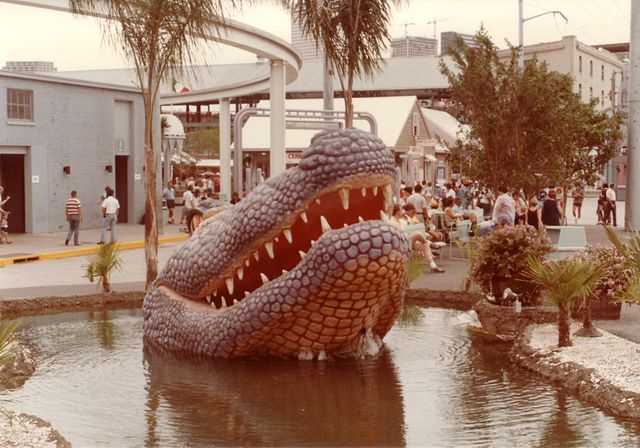

For a long time, hosting a World’s Fair was an extremely big deal. People would travel across the globe to a host city to experience the newest, cutting edge technologies and learn about different cultures.
New Orleans hosted its first World’s Fair in 1884, mostly in what is now Audubon Park. But our fair city wasn’t satisfied stopping at just one!
Exactly one century later, the Big Easy hosted a second fair: the 1984 Louisiana World Exposition. It even had a theme, which was “The World of Rivers — Fresh Waters as a Source of Life.”
This centennial fair, however, wasn’t exactly a resounding success. By the 1980s, unlike one hundred years earlier, globalization had made connecting to the rest of the world from your home more common. Additionally, Disney World’s EPCOT was basically a permanent World’s Fair just a short flight away. Finally, the 1984 Louisiana World Exposition was in direct competition for travelers with the 1984 Summer Olympics, and the Knoxville World’s Fair held only two years earlier.

The New Orleans celebration attracted 7.3 Million visitors during its half-year run. That sounds like a lot, but it was less than two-thirds of the projected attendance, making ours the only World’s Fair to declare bankruptcy mid-run. Possibly because of this, New Orleans’ event marked the final World’s Fair held in the United States.
But it would be cynical to call the 1984 Exposition a total failure. For a generation of New Orleanians, it provided memories that are cherished to this day. Not only that, but it literally helped to transform the city. We can still see evidence of that transformation today, as well as relics from that special time. This post will help guide you through where to find them, many of which remain on display in front of our very eyes.
Revitalization
Today, New Orleans’ Warehouse District is lively. It’s full of restaurants, bars, clubs, and art galleries. Before the World’s Fair, though, the neighborhood featured old, decaying warehouses and trash-strewn streets in disrepair.
No thoroughfare better exemplifies this transformation than Fulton Street. Before the mid-1980s, this wasn’t a street on which to hang out. But as the 84-acre World’s Fair approached, many of the Warehouse District’s streets received a facelift and the newly-created Fulton Street Mall was billed as the hub of the World’s Fair nightlife.

The results of that investment can still be seen today. The Mall’s fun has shifted a few blocks downriver toward Poydras Street, but locals and tourists still enjoy the pedestrian-friendly Fulton Alley, featuring Manning’s sports bar, Ernst Cafe, Harrah’s Casino, a bowling alley, and much more.
In addition, some of the buildings and sites built or rehabilitated for the World’s Fair are still in use today around the Warehouse District. The area known as Festival Park, for example, was anchored by the Federal Fibre Mills Building. During the Exposition, the building housed a German beer garden and the memorable Jed’s Lookout over the Mississippi River. Today, the same building is known as the Federal Fibre Mills Condominiums.
It’s common for world’s fairs to feature pavilions hosted by countries from across the globe. The current Hyatt Place Hotel, for instance, is on the site of what was the fair’s Vatican City Pavilion. Similarly, the location of the New Orleans Pavilion is now occupied by the Omni Riverfront Hotel.
Most of the international pavilions were along a section of the Exposition known as the International Waterfront. After the event closed, those pavilions were redeveloped into their current use, and one of the Fair’s most enduring legacies: the Riverwalk Mall.
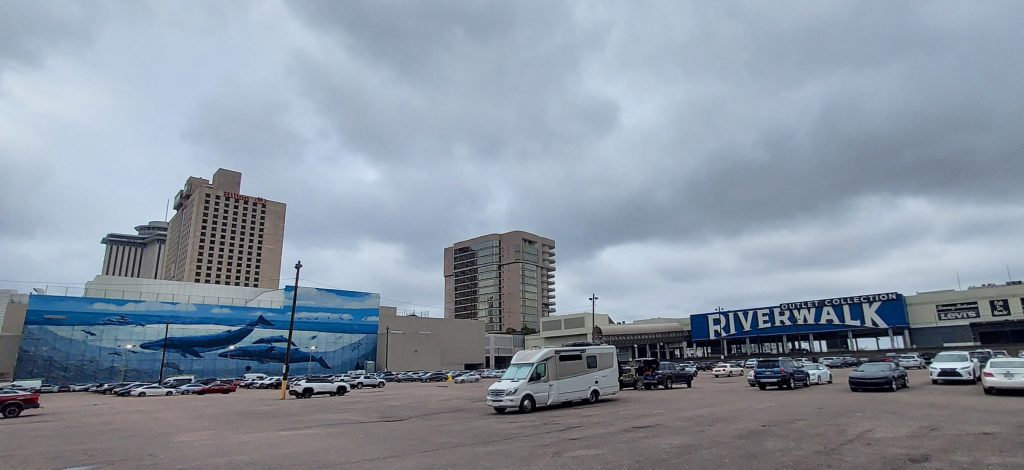
Nearly everything in the area carries history. Even the parking lots! What’s known today as “The Whale Lot,” because of the undersea mural created by artist Robert Wyland after the Fair closed, was once the centrally located Centennial Plaza. The plaza sat just inside the main City Gate entrance to the Fair and featured an aquarium, petroleum-related demonstration, gondola and monorail stations, live old-timey music, and more. Perhaps most amazing was the plaza’s view: if you stood at a certain location, the various buildings of the World’s Fair’s skyline aligned to look like the main hall from the 1884 Exposition!
Convention Center
City officials had been talking about building a convention center in New Orleans years before the World’s Fair. But the Exposition finally provided the catalyst.
What are today Halls A, B, and C of Ernest N. Morial Convention Center were originally built to be the festival’s 300,000-square-foot Great Hall — an air-conditioned indoor facility, home to many of the fair’s state and corporate exhibits. The most popular among them was the Louisiana exhibit, featuring an indoor Disney-style boat ride.
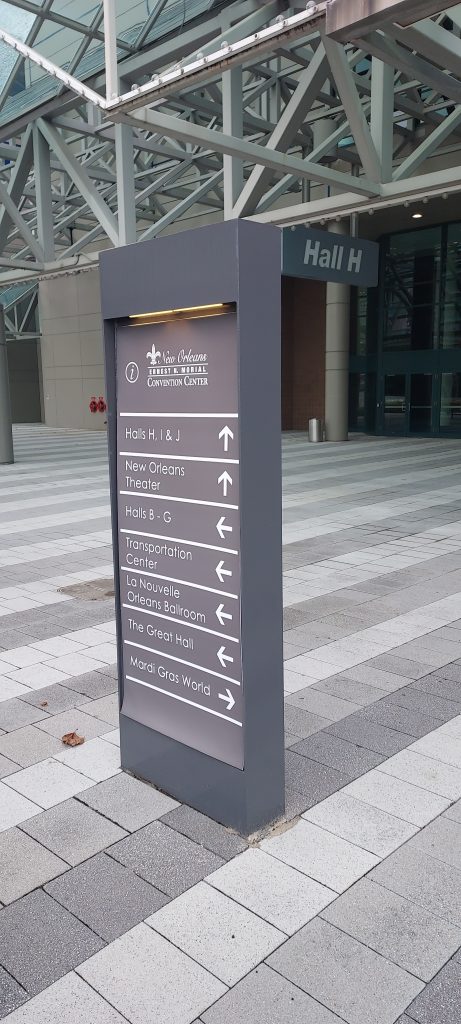
Even today, a section of the convention center is known as The Great Hall.
And the center has expanded repeatedly since opening in 1984. What are now Halls D, E, and F was once the Exposition’s Bayou Plaza neighborhood (the fair featured six “neighborhoods” in total) with water attractions like the Aquacade and Kid Wash.
Neptune and the Alligator
The 1984 World’s Fair had two public entrances. The first, City Gate, was mentioned above. It was surrounded by a pair of buxom, topless mermaids which received a lot of attention at the time. However, it was the other gate, Bridge Gate, that boasts the more enduring legacy.
The Bridge Gate was located on what is now Convention Center Boulevard in the shadow of the Crescent City Connection bridge. Like those shapely mermaids, sculptures also surrounded this entrance. In this case, though, it was family-friendly with visitors welcomed by oversized alligators, a more modest mermaid, and the god of water King Neptune, himself.
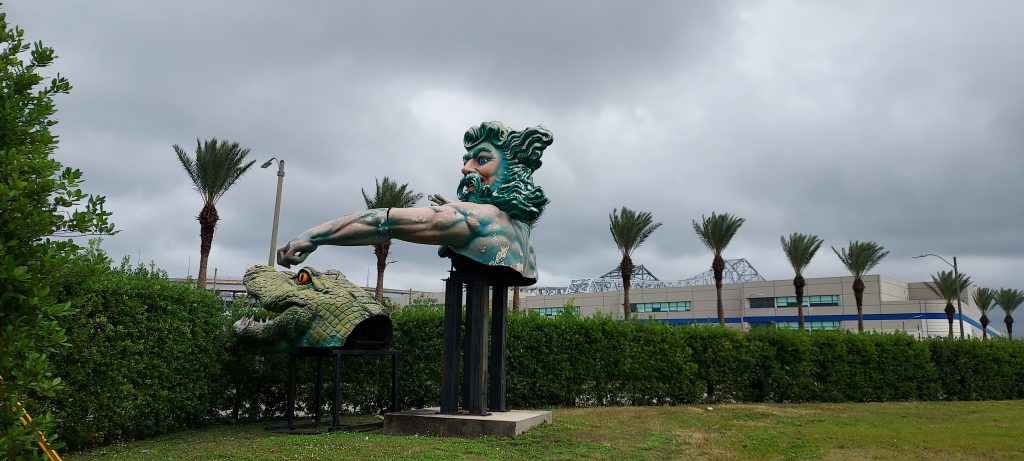
These works of art were created by Blaine Kern of Kern Studios, a company that has created Mardi Gras floats for more than 90 years.
Two of Kern’s Bridge Gate sculptures can still be found around town today. The head of the alligator and a trident-less Neptune sit on the corner of Tchoupitoulas and Henderson streets, pointing the way to Blaine Kern’s Mardi Gras World.
Gondola
One of the most popular attractions at the World’s Fair was the Mississippi Aerial River Transit (MART). It was a gondola lift that took attendees on a 2,200-foot journey to the West Bank and back.
To do that, the gondolas traversed nearly 350 feet in the air over the mighty Mississippi River! By most accounts, this could be a terrifying journey, especially on a windy day. In fact, the gondolas and Disney’s Space Mountain were considered the two best thrill rides in America.
Adding to that thrill, the gondola cars — of which there were more than 50 — were notorious for getting stuck. Unfortunate riders were left dangling in the wind over one of the world’s largest rivers until the ride could be fixed.
(Watch this clip from the 1985 film, French Quarter Undercover to glimpse the gondolas in action.)
More than 1.7 Million riders enjoyed (or at least took) the memorable trip during the Exposition. After the Fair closed, however, the idea was to keep MART as an alternative to the bridge or ferries across the river, but ridership was so low that the gondolas shut down for good in April 1985. Plans to reopen the system never materialized and, in 1989, the gondolas were auctioned away.
They can be found in private residences (and even reportedly in a hunting cabin) far from New Orleans. But at least one remains nearby. Gondola #26 can be found — still largely intact — outside Nesbit’s Poeyfarre Street Market on Poeyfarre Street between Annunciation and Constance streets.
Wonderwall
Noted architect Charles Moore (of Piazza d’Italia fame) and his partner William Turnbull created the Wonderwall, which ran nearly the entire length of Convention Center Boulevard. The wall served the dual purpose of camouflaging ugly power lines while also creating a memorable highlight for fairgoers. One writer described the half-mile Wonderwall as “the Great Wall of China a la Harpo Marx” with its smattering of bombastic sculptures, scaffolding, architectural forms, and landscaping.
After the Fair, many of the attractions were disassembled and sold. The Wonderwall was no different, but some of its pieces can still be found around town. Several of the wall’s silver leaf sculptures, for example, are in the waterfront-facing yard of a home on Demourelles Island along Bayou St. John.
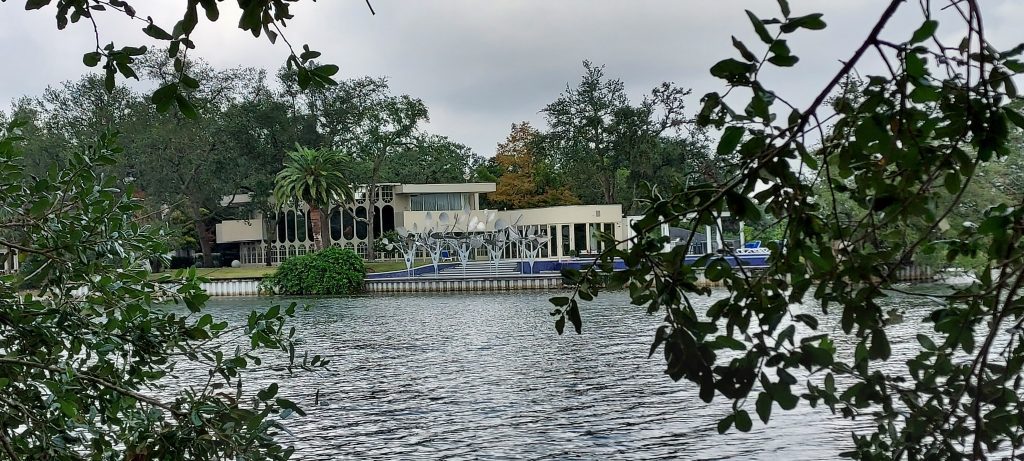
Monorail
The 1984 World’s Fair featured a 1.5-mile monorail that zipped through five of the ground’s six “neighborhoods” on an elevated track. A complete circuit took 12 minutes and, memorably, the train even passed through the inside of several pavilions. Many fairgoers used the monorail as a chance to get their bearings before jumping into the festival by foot.
The post-Exposition plan was for the $15 Million monorail to serve as public transportation through sections of the CBD, but after the Fair went bankrupt, the monorail was sold to Zoo Miami where it was refurbished and in use until 2022, when it was finally retired.
Public Art
The festival also held an international art competition based on its theme of water. Winners were scattered throughout the Exposition and several of those art installations still exist in New Orleans today.
One of the first works of art attendees would see at the 1984 World’s Fair was a gigantic head, laying on its side with water leaking from its eyes. The piece, called “Crying Head,” was created by Claude and Francois-Xavier Lalanne. Today, it can be found on the Elk Place neutral ground between Tulane Avenue and Canal Street.
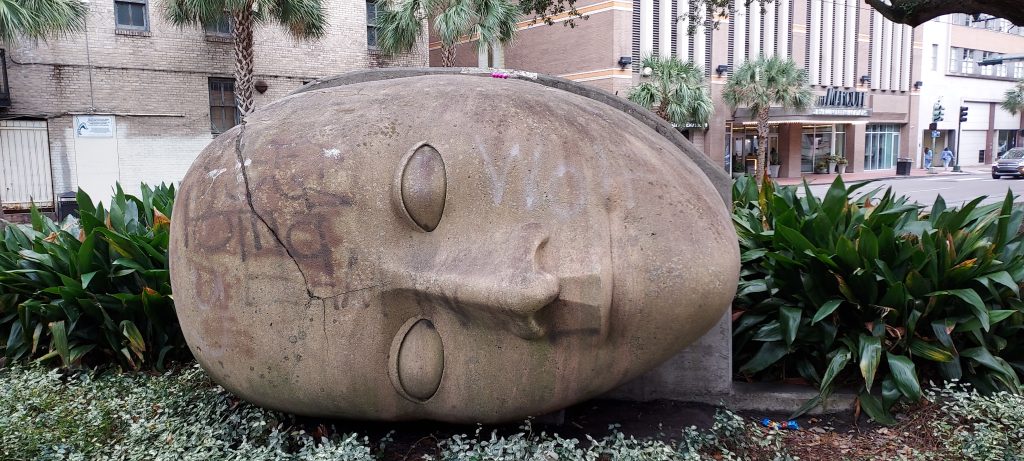
A second piece of art at the festival was “The Wave of the World,” by Lynda Benglis. It was located near “Crying Head” at the Exhibition, but after the Fair closed, a series of mix-ups resulted in the award-winning sculpture lost in storage for decades at Kenner’s former sewerage treatment plant.
After “The Wave of the World” was rediscovered, and its immense value realized, the artwork was restored and is now on loan, residing in City Park along Big Lake near the Esplanade Avenue entrance.
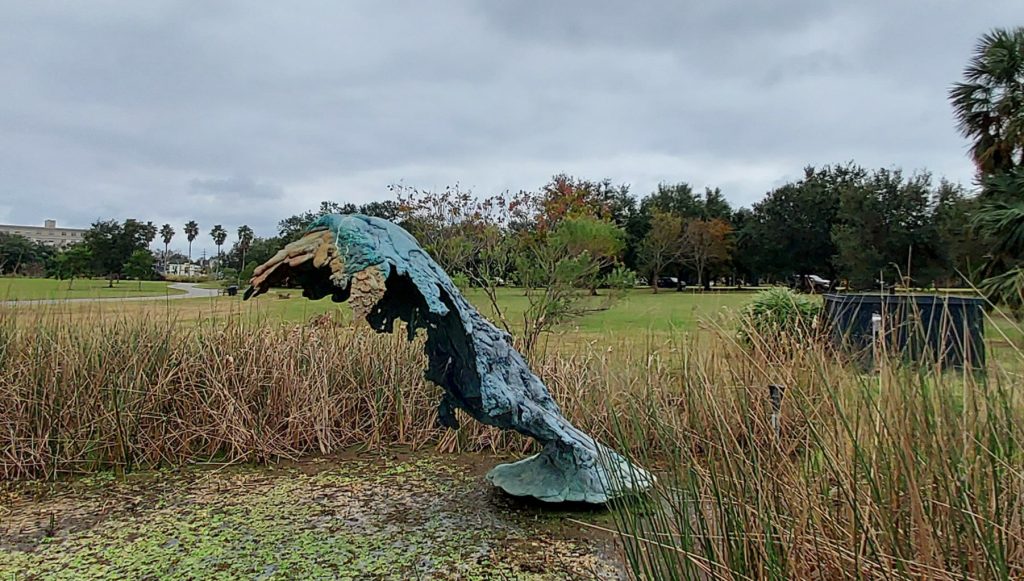
Food
It’s hard to believe, but there was a time when crawfish was rarely eaten in New Orleans. Before the World’s Fair, those delicious mudbugs were much more likely to be consumed near the bayous of Cajun Country.
Due to newer harvesting methods, however, the increasingly popular crawfish was finally making its way to the Crescent City just in time for the World’s Fair. That, in addition to the rise of the charismatic Paul Prudhomme and his new book, Chef Paul Prudhomme’s Louisiana Kitchen, ensured food writers dispatched to the Exposition had plenty to share with the outside world.
They wrote articles about Creole and Cajun food, which had the effect of inspiring travelers to venture to New Orleans in the years after the festival for its unique regional cuisines.
Local chefs gave those travelers what they wanted, adding a larger number of Cajun dishes to their menus to stand beside already-popular Creole offerings.
Because the 1984 Louisiana World Exposition’s coverage of Creole and Cajun food helped to popularize Louisiana cooking across the world, it’s hard to travel to a far-off city without finding our food represented there — even if the taste isn’t always quite right.
But, as you’ve seen, food is just one of many ways New Orleans’ second World’s Fair created lasting memories and transformed our city.